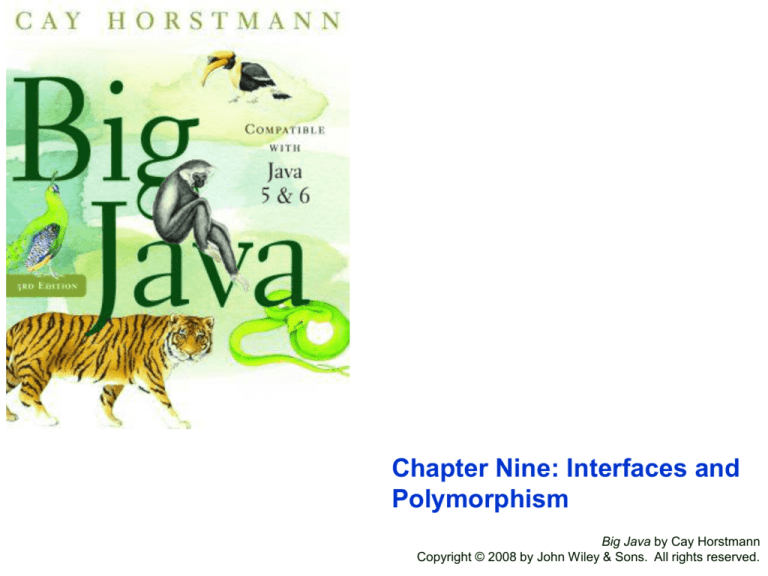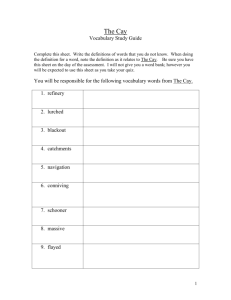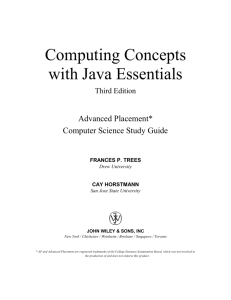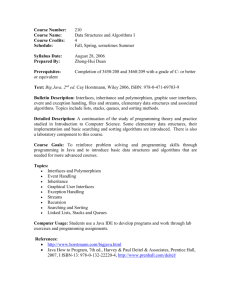
Chapter Nine: Interfaces and
Polymorphism
Big Java by Cay Horstmann
Copyright © 2008 by John Wiley & Sons. All rights reserved.
Chapter Goals
• To learn about interfaces
• To be able to convert between class and interface references
• To understand the concept of polymorphism
• To appreciate how interfaces can be used to decouple classes
• To learn how to implement helper classes as inner classes
• To understand how inner classes access variables from the
surrounding scope
• To implement event listeners in graphical applications
Big Java by Cay Horstmann
Copyright © 2008 by John Wiley & Sons. All rights reserved.
Using Interfaces for Code Reuse
• Use interface types to make code more reusable
• In Chapter 6, we created a DataSet to find the average and
maximum of a set of values (numbers)
• What if we want to find the average and maximum of a set of
BankAccount values?
Continued
Big Java by Cay Horstmann
Copyright © 2008 by John Wiley & Sons. All rights reserved.
Using Interfaces for Code Reuse (cont.)
public class DataSet // Modified for BankAccount objects
{
. . .
public void add(BankAccount x)
{
sum = sum + x.getBalance();
if (count == 0 || maximum.getBalance() <
x.getBalance()) maximum = x;
count++;
}
public BankAccount getMaximum()
{
return maximum;
}
private double sum;
private BankAccount maximum;
private int count;
}
Big Java by Cay Horstmann
Copyright © 2008 by John Wiley & Sons. All rights reserved.
Using Interfaces for Code Reuse
Or suppose we wanted to find the coin with the highest value
among a set of coins. We would need to modify the DataSet
class again:
public class DataSet // Modified for Coin objects
{
. . .
public void add(Coin x)
{
sum = sum + x.getValue();
if (count == 0 || maximum.getValue() <
x.getValue()) maximum = x;
count++;
}
Continued
Big Java by Cay Horstmann
Copyright © 2008 by John Wiley & Sons. All rights reserved.
Using Interfaces for Code Reuse
public Coin getMaximum()
{
return maximum;
}
private double sum;
private Coin maximum;
private int count;
}
Big Java by Cay Horstmann
Copyright © 2008 by John Wiley & Sons. All rights reserved.
Using Interfaces for Code Reuse
• The mechanics of analyzing the data is the same in all cases;
details of measurement differ
• Classes could agree on a method getMeasure that obtains the
measure to be used in the analysis
• We can implement a single reusable DataSet class whose add
method looks like this:
sum = sum + x.getMeasure();
if (count == 0 || maximum.getMeasure() <
x.getMeasure())
maximum = x;
count++;
Continued
Big Java by Cay Horstmann
Copyright © 2008 by John Wiley & Sons. All rights reserved.
Using Interfaces for Code Reuse (cont.)
• What is the type of the variable x?
x should refer to any class that has a getMeasure method
• In Java, an interface type is used to specify required operations
public interface Measurable
{
double getMeasure();
}
• Interface declaration lists all methods (and their signatures) that
the interface type requires
Big Java by Cay Horstmann
Copyright © 2008 by John Wiley & Sons. All rights reserved.
Interfaces vs. Classes
An interface type is similar to a class, but there are several
important differences:
• All methods in an interface type are abstract; they don't have an implementation
• All methods in an interface type are automatically public
• An interface type does not have instance fields
Big Java by Cay Horstmann
Copyright © 2008 by John Wiley & Sons. All rights reserved.
Generic DataSet for Measurable Objects
public class DataSet
{
. . .
public void add(Measurable x)
{
sum = sum + x.getMeasure();
if (count == 0 || maximum.getMeasure() <
x.getMeasure())
maximum = x;
count++;
}
public Measurable getMaximum()
{
return maximum;
}
Continued
Big Java by Cay Horstmann
Copyright © 2008 by John Wiley & Sons. All rights reserved.
Generic DataSet for Measurable Objects
private double sum;
private Measurable maximum;
private int count;
}
Big Java by Cay Horstmann
Copyright © 2008 by John Wiley & Sons. All rights reserved.
Implementing an Interface Type
• Use implements keyword to indicate that a class implements
an interface type
public class BankAccount implements Measurable
{
public double getMeasure()
{
return balance;
}
// Additional methods and fields
}
• A class can implement more than one interface type
• Class must define all the methods that are required by all the
interfaces it implements
Continued
Big Java by Cay Horstmann
Copyright © 2008 by John Wiley & Sons. All rights reserved.
Implementing an Interface Type (cont.)
• Use implements keyword to indicate that a class implements
an interface type
public class BankAccount implements Measurable
{
public double getMeasure()
{
return balance;
}
// Additional methods and fields
}
• A class can implement more than one interface type
• Class must define all the methods that are required by all the
interfaces it implements
Big Java by Cay Horstmann
Copyright © 2008 by John Wiley & Sons. All rights reserved.
UML Diagram of DataSet and Related Classes
• Interfaces can reduce the coupling between classes
• UML notation:
• Interfaces are tagged with a "stereotype" indicator «interface»
• A dotted arrow with a triangular tip denotes the "is-a" relationship
between a class and an interface
• A dotted line with an open v-shaped arrow tip denotes the "uses"
relationship or dependency
• Note that DataSet is decoupled from BankAccount and Coin
Big Java by Cay Horstmann
Copyright © 2008 by John Wiley & Sons. All rights reserved.
Syntax 9.1 Defining an Interface
public interface InterfaceName
{
// method signatures
}
Example:
public interface Measurable
{
double getMeasure();
}
Purpose:
To define an interface and its method signatures. The methods
are automatically public.
Big Java by Cay Horstmann
Copyright © 2008 by John Wiley & Sons. All rights reserved.
Syntax 9.2 Implementing an Interface
public class ClassName
implements InterfaceName, InterfaceName, ...
{
// methods
// instance variables
}
Example:
public class BankAccount implements Measurable
{
// Other BankAccount methods
public double getMeasure()
{
// Method implementation
}
Continued
}
Big Java by Cay Horstmann
Copyright © 2008 by John Wiley & Sons. All rights reserved.
Syntax 9.2 Implementing an Interface (cont.)
Purpose:
To define a new class that implements the methods of an
interface.
Big Java by Cay Horstmann
Copyright © 2008 by John Wiley & Sons. All rights reserved.
ch09/measure1/DataSetTester.java
01:
02:
03:
04:
05:
06:
07:
08:
09:
10:
11:
12:
13:
14:
15:
16:
17:
18:
19:
20:
21:
/**
This program tests the DataSet class.
*/
public class DataSetTester
{
public static void main(String[] args)
{
DataSet bankData = new DataSet();
bankData.add(new BankAccount(0));
bankData.add(new BankAccount(10000));
bankData.add(new BankAccount(2000));
System.out.println("Average balance: "
+ bankData.getAverage());
System.out.println("Expected: 4000");
Measurable max = bankData.getMaximum();
System.out.println("Highest balance: "
+ max.getMeasure());
System.out.println("Expected: 10000");
Big Java by Cay Horstmann
Copyright © 2008 by John Wiley & Sons. All rights reserved.
ch09/measure1/DataSetTester.java (cont.)
22:
23:
24:
25:
26:
27:
28:
29:
30:
31:
32:
33:
34:
35:
36: }
DataSet coinData = new DataSet();
coinData.add(new Coin(0.25, "quarter"));
coinData.add(new Coin(0.1, "dime"));
coinData.add(new Coin(0.05, "nickel"));
System.out.println("Average coin value: "
+ coinData.getAverage());
System.out.println("Expected: 0.133");
max = coinData.getMaximum();
System.out.println("Highest coin value: "
+ max.getMeasure());
System.out.println("Expected: 0.25");
}
Big Java by Cay Horstmann
Copyright © 2008 by John Wiley & Sons. All rights reserved.
ch09/measure1/DataSetTester.java (cont.)
Output:
Average balance: 4000.0
Expected: 4000
Highest balance: 10000.0
Expected: 10000
Average coin value: 0.13333333333333333
Expected: 0.133
Highest coin value: 0.25
Expected: 0.25
Big Java by Cay Horstmann
Copyright © 2008 by John Wiley & Sons. All rights reserved.
Self Check 9.1
Suppose you want to use the DataSet class to find the Country
object with the largest population. What condition must the
Country class fulfill?
Answer: It must implement the Measurable interface, and its
getMeasure method must return the population.
Big Java by Cay Horstmann
Copyright © 2008 by John Wiley & Sons. All rights reserved.
Self Check 9.2
Why can't the add method of the DataSet class have a parameter
of type Object?
Answer: The Object class doesn't have a getMeasure method,
and the add method invokes the getMeasure method.
Big Java by Cay Horstmann
Copyright © 2008 by John Wiley & Sons. All rights reserved.
Converting Between Class and Interface Types
• You can convert from a class type to an interface type, provided
the class implements the interface
• BankAccount account = new BankAccount(10000);
Measurable x = account; // OK
• Coin dime = new Coin(0.1, "dime");
Measurable x = dime; // Also OK
• Cannot convert between unrelated types
Measurable x = new Rectangle(5, 10, 20, 30); // ERROR
• Because Rectangle doesn't implement Measurable
Big Java by Cay Horstmann
Copyright © 2008 by John Wiley & Sons. All rights reserved.
Casts
• Add coin objects to DataSet
DataSet coinData
coinData.add(new
coinData.add(new
. . .
Measurable max =
largest coin
= new DataSet();
Coin(0.25, "quarter"));
Coin(0.1, "dime"));
coinData.getMaximum(); // Get the
• What can you do with it? It's not of type Coin
String name = max.getName(); // ERROR
• You need a cast to convert from an interface type to a class type
• You know it's a coin, but the compiler doesn't. Apply a cast:
Coin maxCoin = (Coin) max;
String name = maxCoin.getName();
Continued
Big Java by Cay Horstmann
Copyright © 2008 by John Wiley & Sons. All rights reserved.
Casts (cont.)
• If you are wrong and max isn't a coin, the compiler throws an
exception
• Difference with casting numbers:
When casting number types you agree to the information loss
When casting object types you agree to that risk of causing an
exception
Big Java by Cay Horstmann
Copyright © 2008 by John Wiley & Sons. All rights reserved.
Self Check 9.3
Can you use a cast (BankAccount) x to convert a Measurable
variable x to a BankAccount reference?
Answer: Only if x actually refers to a BankAccount object.
Big Java by Cay Horstmann
Copyright © 2008 by John Wiley & Sons. All rights reserved.
Self Check 9.4
If both BankAccount and Coin implement the Measurable
interface, can a Coin reference be converted to a BankAccount
reference?
Answer: No – a Coin reference can be converted to a
Measurable reference, but if you attempt to cast that reference to
a BankAccount, an exception occurs.
Big Java by Cay Horstmann
Copyright © 2008 by John Wiley & Sons. All rights reserved.
Polymorphism
• Interface variable holds reference to object of a class that
implements the interface
Measurable x;
x = new BankAccount(10000);
x = new Coin(0.1, "dime");
• Note that the object to which x refers doesn't have type
Measurable; the type of the object is some class that implements
the Measurable interface
• You can call any of the interface methods:
double m = x.getMeasure();
• Which method is called?
Big Java by Cay Horstmann
Copyright © 2008 by John Wiley & Sons. All rights reserved.
Polymorphism
• Depends on the actual object
• If x refers to a bank account, calls BankAccount.getMeasure
• If x refers to a coin, calls Coin.getMeasure
• Polymorphism (many shapes): Behavior can vary depending on
the actual type of an object
• Called late binding: resolved at runtime
• Different from overloading; overloading is resolved by the
compiler (early binding)
Big Java by Cay Horstmann
Copyright © 2008 by John Wiley & Sons. All rights reserved.
Animation 9.1 –
Big Java by Cay Horstmann
Copyright © 2008 by John Wiley & Sons. All rights reserved.
Self Check 9.5
Why is it impossible to construct a Measurable object?
Answer: Measurable is an interface. Interfaces have no fields
and no method implementations.
Big Java by Cay Horstmann
Copyright © 2008 by John Wiley & Sons. All rights reserved.
Self Check 9.6
Why can you nevertheless declare a variable whose type is
Measurable?
Answer: That variable never refers to a Measurable object. It
refers to an object of some class – a class that implements the
Measurable interface.
Big Java by Cay Horstmann
Copyright © 2008 by John Wiley & Sons. All rights reserved.
Self Check 9.7
What do overloading and polymorphism have in common? Where
do they differ?
Answer: Both describe a situation where one method name can
denote multiple methods. However, overloading is resolved
early by the compiler, by looking at the types of the parameter
variables. Polymorphism is resolved late, by looking at the type
of the implicit parameter object just before making the call.
Big Java by Cay Horstmann
Copyright © 2008 by John Wiley & Sons. All rights reserved.
Using Interfaces for Callbacks
• Limitations of Measurable interface:
• Can add Measurable interface only to classes under your control
• Can measure an object in only one way
E.g., cannot analyze a set of savings accounts both by bank balance and
by interest rate
• Callback mechanism: allows a class to call back a specific
method when it needs more information
• In previous DataSet implementation, responsibility of measuring
lies with the added objects themselves
Continued
Big Java by Cay Horstmann
Copyright © 2008 by John Wiley & Sons. All rights reserved.
Using Interfaces for Callbacks (cont.)
• Alternative: Hand the object to be measured to a method:
public interface Measurer
{
double measure(Object anObject);
}
• Object is the "lowest common denominator" of all classes
Big Java by Cay Horstmann
Copyright © 2008 by John Wiley & Sons. All rights reserved.
Using Interfaces for Callbacks
add method asks measurer (and not the added object) to do the
measuring:
public void add(Object x)
{
sum = sum + measurer.measure(x);
if (count == 0 || measurer.measure(maximum) <
measurer.measure(x))
maximum = x;
count++;
}
Big Java by Cay Horstmann
Copyright © 2008 by John Wiley & Sons. All rights reserved.
Using Interfaces for Callbacks
• You can define measurers to take on any kind of measurement
public class RectangleMeasurer implements Measurer
{
public double measure(Object anObject)
{
Rectangle aRectangle = (Rectangle) anObject;
double area = aRectangle.getWidth() *
aRectangle.getHeight();
return area;
}
}
• Must cast from Object to Rectangle
Rectangle aRectangle = (Rectangle) anObject;
Continued
Big Java by Cay Horstmann
Copyright © 2008 by John Wiley & Sons. All rights reserved.
Using Interfaces for Callbacks (cont.)
• Pass measurer to data set constructor:
Measurer m =
DataSet data
data.add(new
data.add(new
new RectangleMeasurer();
= new DataSet(m);
Rectangle(5, 10, 20, 30));
Rectangle(10, 20, 30, 40)); . . .
Big Java by Cay Horstmann
Copyright © 2008 by John Wiley & Sons. All rights reserved.
UML Diagram of Measurer Interface and Related Classes
Note that the Rectangle class is decoupled from the Measurer
interface
Big Java by Cay Horstmann
Copyright © 2008 by John Wiley & Sons. All rights reserved.
ch09/measure2/DataSet.java
01: /**
02:
Computes the average of a set of data values.
03: */
04: public class DataSet
05: {
06:
/**
07:
Constructs an empty data set with a given measurer.
08:
@param aMeasurer the measurer that is used to measure data
values
09:
*/
10:
public DataSet(Measurer aMeasurer)
11:
{
12:
sum = 0;
13:
count = 0;
14:
maximum = null;
15:
measurer = aMeasurer;
16:
}
17:
18:
/**
19:
Adds a data value to the data set.
20:
@param x a data value
Continued
21:
*/
Big Java by Cay Horstmann
Copyright © 2008 by John Wiley & Sons. All rights reserved.
ch09/measure2/DataSet.java (cont.)
22:
23:
24:
25:
26:
27:
28:
29:
30:
31:
32:
33:
34:
35:
36:
37:
38:
39:
40:
public void add(Object x)
{
sum = sum + measurer.measure(x);
if (count == 0
|| measurer.measure(maximum) < measurer.measure(x))
maximum = x;
count++;
}
/**
Gets the average of the added data.
@return the average or 0 if no data has been added
*/
public double getAverage()
{
if (count == 0) return 0;
else return sum / count;
}
Continued
Big Java by Cay Horstmann
Copyright © 2008 by John Wiley & Sons. All rights reserved.
ch09/measure2/DataSet.java (cont.)
41:
42:
43:
44:
45:
46:
47:
48:
49:
50:
51:
52:
53:
54: }
/**
Gets the largest of the added data.
@return the maximum or 0 if no data has been added
*/
public Object getMaximum()
{
return maximum;
}
private
private
private
private
double sum;
Object maximum;
int count;
Measurer measurer;
Big Java by Cay Horstmann
Copyright © 2008 by John Wiley & Sons. All rights reserved.
ch09/measure2/DataSetTester2.java
01:
02:
03:
04:
05:
06:
07:
08:
09:
10:
11:
12:
13:
14:
15:
16:
17:
18:
19:
20:
import java.awt.Rectangle;
/**
This program demonstrates the use of a Measurer.
*/
public class DataSetTester2
{
public static void main(String[] args)
{
Measurer m = new RectangleMeasurer();
DataSet data = new DataSet(m);
data.add(new Rectangle(5, 10, 20, 30));
data.add(new Rectangle(10, 20, 30, 40));
data.add(new Rectangle(20, 30, 5, 15));
System.out.println("Average area: " + data.getAverage());
System.out.println("Expected: 625");
Continued
Big Java by Cay Horstmann
Copyright © 2008 by John Wiley & Sons. All rights reserved.
ch09/measure2/DataSetTester2.java (cont.)
21:
Rectangle max = (Rectangle) data.getMaximum();
22:
System.out.println("Maximum area rectangle: " + max);
23:
System.out.println("Expected:
java.awt.Rectangle[x=10,y=20,width=30,height=40]");
24:
}
25: }
Big Java by Cay Horstmann
Copyright © 2008 by John Wiley & Sons. All rights reserved.
ch09/measure2/Measurer.java
01:
02:
03:
04:
05:
06:
07:
08:
09:
10:
11:
12:
/**
Describes any class whose objects can measure other objects.
*/
public interface Measurer
{
/**
Computes the measure of an object.
@param anObject the object to be measured
@return the measure
*/
double measure(Object anObject);
}
Big Java by Cay Horstmann
Copyright © 2008 by John Wiley & Sons. All rights reserved.
ch09/measure2/RectangleMeasurer.java
01:
02:
03:
04:
05:
06:
07:
08:
09:
10:
11:
12:
13:
14:
import java.awt.Rectangle;
/**
Objects of this class measure rectangles by area.
*/
public class RectangleMeasurer implements Measurer
{
public double measure(Object anObject)
{
Rectangle aRectangle = (Rectangle) anObject;
double area = aRectangle.getWidth() * aRectangle.getHeight();
return area;
}
}
Big Java by Cay Horstmann
Copyright © 2008 by John Wiley & Sons. All rights reserved.
ch09/measure2/RectangleMeasurer.java (cont.)
Output:
Average area: 625
Expected: 625
Maximum area rectangle:java.awt.Rectangle[x=10,y=20,
width=30,height=40]
Expected: java.awt.Rectangle[x=10,y=20,width=30,height=40]
Big Java by Cay Horstmann
Copyright © 2008 by John Wiley & Sons. All rights reserved.
Self Check 9.8
Suppose you want to use the DataSet class of Section 9.1 to find
the longest String from a set of inputs. Why can't this work?
Answer: The String class doesn't implement the Measurable
interface.
Big Java by Cay Horstmann
Copyright © 2008 by John Wiley & Sons. All rights reserved.
Self Check 9.10
Why does the measure method of the Measurer interface have one
more parameter than the getMeasure method of the Measurable
interface?
Answer: A measurer measures an object, whereas getMeasure
measures "itself", that is, the implicit parameter.
Big Java by Cay Horstmann
Copyright © 2008 by John Wiley & Sons. All rights reserved.
Inner Classes
• Trivial class can be defined inside a method
public class DataSetTester3
{
public static void main(String[] args)
{
class RectangleMeasurer implements Measurer
{
. . .
}
Measurer m = new RectangleMeasurer();
DataSet data = new DataSet(m);
. . .
}
}
Continued
Big Java by Cay Horstmann
Copyright © 2008 by John Wiley & Sons. All rights reserved.
Inner Classes (cont.)
• If inner class is defined inside an enclosing class, but outside
its methods, it is available to all methods of enclosing class
• Compiler turns an inner class into a regular class file:
DataSetTester$1$RectangleMeasurer.class
Big Java by Cay Horstmann
Copyright © 2008 by John Wiley & Sons. All rights reserved.
Syntax 9.3 Inner Classes
Declared inside a method
Declared inside the class
class OuterClassName
{
method signature
{
. . .
class InnerClassName
{
// methods
// fields
}
. . .
}
. . .
}
class OuterClassName
{
// methods
// fields
accessSpecifier class
InnerClassName
{
// methods
// fields
}
. . .
}
Continued
Big Java by Cay Horstmann
Copyright © 2008 by John Wiley & Sons. All rights reserved.
Syntax 9.3 Inner Classes
Example:
public class Tester
{
public static void main(String[] args)
{
class RectangleMeasurer implements Measurer
{
. . .
}
. . .
}
}
Purpose:
To define an inner class whose scope is restricted to a single
method or the methods of a single class.
Big Java by Cay Horstmann
Copyright © 2008 by John Wiley & Sons. All rights reserved.
ch09/measure3/DataSetTester3.java
01:
02:
03:
04:
05:
06:
07:
08:
09:
10:
11:
12:
13:
14:
15:
16:
17:
18:
19:
20:
import java.awt.Rectangle;
/**
This program demonstrates the use of an inner class.
*/
public class DataSetTester3
{
public static void main(String[] args)
{
class RectangleMeasurer implements Measurer
{
public double measure(Object anObject)
{
Rectangle aRectangle = (Rectangle) anObject;
double area
= aRectangle.getWidth() * aRectangle.getHeight();
return area;
}
}
Continued
Big Java by Cay Horstmann
Copyright © 2008 by John Wiley & Sons. All rights reserved.
ch09/measure3/DataSetTester3.java (cont.)
21:
Measurer m = new RectangleMeasurer();
22:
23:
DataSet data = new DataSet(m);
24:
25:
data.add(new Rectangle(5, 10, 20, 30));
26:
data.add(new Rectangle(10, 20, 30, 40));
27:
data.add(new Rectangle(20, 30, 5, 15));
28:
29:
System.out.println("Average area: " + data.getAverage());
30:
System.out.println("Expected: 625");
31:
32:
Rectangle max = (Rectangle) data.getMaximum();
33:
System.out.println("Maximum area rectangle: " + max);
34:
System.out.println("Expected:
java.awt.Rectangle[x=10,y=20,width=30,height=40]");
35:
}
36: }
Big Java by Cay Horstmann
Copyright © 2008 by John Wiley & Sons. All rights reserved.
Self Check 9.11
Why would you use an inner class instead of a regular class?
Answer: Inner classes are convenient for insignificant classes.
Also, their methods can access variables and fields from the
surrounding scope.
Big Java by Cay Horstmann
Copyright © 2008 by John Wiley & Sons. All rights reserved.
Self Check 9.12
How many class files are produced when you compile the
DataSetTester3 program?
Answer: Four: one for the outer class, one for the inner class,
and two for the DataSet and Measurer classes.
Big Java by Cay Horstmann
Copyright © 2008 by John Wiley & Sons. All rights reserved.








